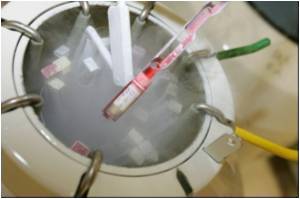Men who have a shorter ano-genital distance have lower sperm counts, poorer quality of sperm, lower sperm concentration in the semen and lower motility of the sperm.

Researchers measured the AGD in about 126 college students. It was found that men whose AGD was shorter than the median length, about 52 millimeters, were 7.3 times more likely to have a low sperm concentration. This study might be helpful in predicting whether men with a low sperm count will be successful in getting a woman pregnant. This technique is non-invasive and does not depend upon temperature and stress. However to determine the normal length of AGD several thousands of men will be required to be measured.
Studies in animals have found that male reproductive problems and shorter AGD have been linked to exposure in the womb to endocrine disrupting chemicals like phthalates which may interfere with testicular development. Phthalates are found in industrial and personal care products like soaps, shampoos and some pesticides. Researchers are speculating whether the same link applies in humans also. Earlier research by swan has shown that during pregnancy women who had high levels of phthalates in the urine gave birth to sons who were 10times more likely to have shorter AGDs.
Source-Medindia














